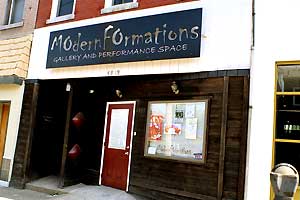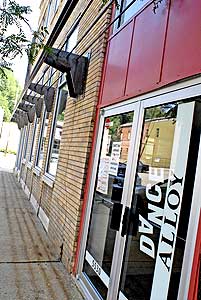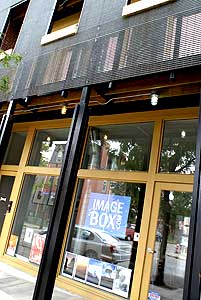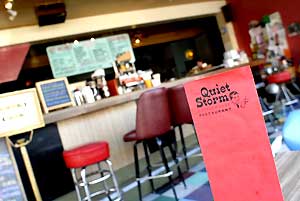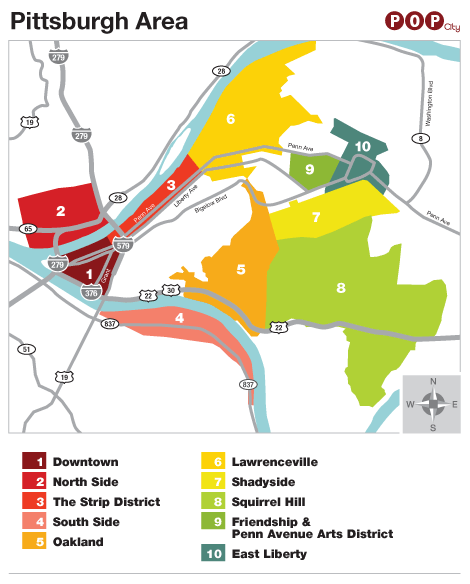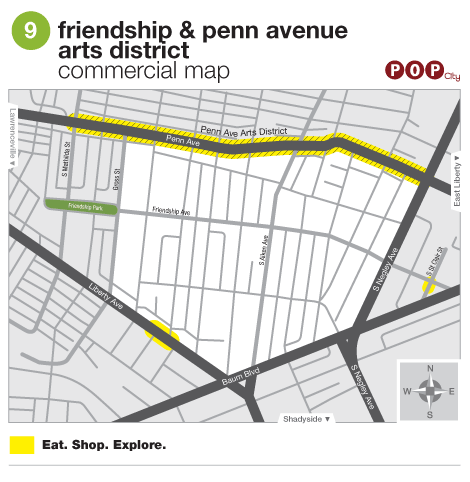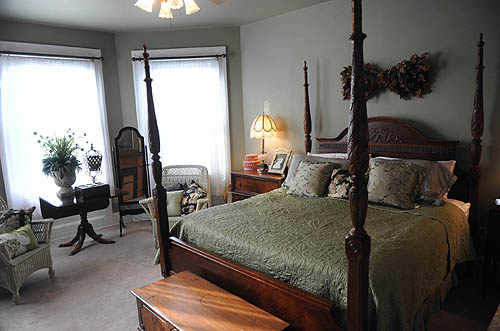
Latest News
-
PENNSYLVANIA AT RISK 2010 ANNOUNCED
December 16, 2010
PENNSYLVANIA AT RISK 2010 ANNOUNCED
Preservation Pennsylvania announces the annual listing of the Commonwealth’s most endangered historic resources.Preservation Pennsylvania, a statewide non-profit historic preservation group, released its annual Pennsylvania At Risk list today, which highlights 11 endangered resources.
Pennsylvania At Risk serves as a representative sampling of the Commonwealth’s most endangered historic resources. For the purpose of the list, endangerment is defined as threat of demolition, significant deterioration, vandalism, alteration, and/or loss of its historic setting. It is Preservation Pennsylvania’s belief that publishing this list draws statewide attention to the plight of Pennsylvania’s historic resources, promotes local action to protect resources, and encourages additional state funding for historic sites.
Resources included on the Pennsylvania At Risk 2010 list include:
East Stroudsburg Railroad Station (East Stroudsburg, Monroe County)
Built in 1864 as the Stroudsburg station on the Delaware, Lackawanna and Western Railroad, the East Stroudsburg Railroad Station is a landmark in the community. The depot’s presence led to rapid commercial growth, establishing Crystal Street as the business hub of a rapidly expanding community. Thanks to the efforts of East Stroudsburg’s residents and supporters, and the partnerships between community groups, non-profits, private corporations and individuals and the borough, the building was saved earlier this year after demolition of the station had begun. However, initial funding to save the 1883 building only covers partial reconstruction and restoration, so efforts to secure the long-term future of the station will need to continue.U.S.S. Olympia (Philadelphia, Philadelphia County)
Built by the United Iron Works of San Francisco in 1890-1893 and commissioned in 1895, the cruiser U.S.S. Olympia is a National Historic Landmark that represents critical points in American history. She served as the flagship of the Asiatic Squadron in the Spanish-American War, and it was from the Olympia’s bridge on May 1, 1898 during the Battle of Manila that
Commodore George Dewey issued the famous command: “You may fire when you are ready, Gridley.” Its final mission was bringing home the body of World War I’s Unknown Soldier fromFrance in 1921. It was decommissioned in 1922, then opened as a museum in 1958. Since taking ownership of the ship in 1996, the Independence Seaport Museum in Philadelphia has spent $5.5 million on repairs, inspections and maintenance of the Olympia; yet, without major a refurbishment and plans for its future use/preservation, the Olympia will either sink at its moorings, be sold for scrap, or be scuttled for an artificial reef off Cape May, New Jersey. While efforts to secure private or public funding for the project have been unsuccessful to date, the National Park Service has begun working with stakeholders to seek a positive preservation outcome. The U.S.S. Olympia was scheduled to close to the public November 22, 2010. However, it was recently announced that she will remain open until January.
Schuylkill School (Schuylkill Township, Chester County)
Schuylkill School was built in 1930 and brought children together from a number of area one- and two-room schoolhouses. Construction of the school was made possible through the philanthropy of Frank B. Foster, who helped fund three consolidated schools in Chester County (the other two of which are still in use). In 2002, the Schuylkill School was determined eligible for inclusion in the National Register of Historic Places; that same year the Phoenixville Area School District began to consider the school’s demolition. Despite studies that have identified several potential new uses for the building, the Phoenixville Area School District plans to begin demolishing the building in December 2010. The ground where the historic school now stands will become a parking lot.Stewartstown Railroad (Stewartstown to New Freedom, York County)
From 1884 to 1972, the Stewartstown Railroad connected farmers and manufacturers to markets in Baltimore. The Stewartstown Railroad remains in business under its original charter of 1884–the only such operation in existence that did not merge with another railroad or was subjected to any form of corporate reorganization. Seven railroad structures along the 7.4-mile line have been listed in the National Register of Historic Places and the line itself has been determined eligible for inclusion in the National Register. The financial generosity of George Hart, President of the Stewartstown Railroad, kept the company operational through recent tough times; however, this resulted in a substantial lien against the railroad. Arrangements to forgive the $352,000 sum were not made in Mr. Hart’s estate plans as expected. Now, unless the Bucks County Historical Society, beneficiary of Mr. Hart’s estate, will agree to defer payment of the lien for several years, the Stewartstown Railroad would be forced to liquidate its assets to raise the $352,000 that it owes.Holland Hall “Huidekoper Mansion” (Meadville, Crawford County) Holland Hall was built by Arthur Clark (A.C.) Huidekoper in 1899 and it survives as Meadville’s only Gilded Age mansion. Holland Hall is currently threatened with demolition. Following the death of Frances Reynolds Huidekoper in 1932, Holland Hall was occupied by Allegheny College’s Phi Delta Theta fraternity who occupied it from 1935 until 1995. It was then sold and has remained vacant for fifteen years. In order to prevent the demolition or continued neglect of Holland Hall, a buyer interested in acquiring and rehabilitating this architecturally significant building is needed.
“Plantation Plenty” Isaac Manchester Farm (Avella, Independence Township, Washington County) Plantation Plenty is a farm of just over 400 acres that has been owned and occupied by the members of the Manchester family for 210 years. The house, completed by Isaac Manchester in 1815, is one of the finest examples of Georgian architecture in Western Pennsylvania. The property is currently operating as a multi-faceted organic farm, producing milk, beef, pork, eggs and a variety of fruits and vegetables. While much of the significance of Plantation Plenty is clearly visible through its buildings, it also contains potentially important prehistoric and historic archaeological sites. Despite the property’s importance, it is now threatened by longwall mining. Subsidence caused by longwall mining under the farm, which causes the ground to drop between 4 and 6 feet at the surface, may cause severe damage to the historic buildings, and will fracture the rock that forms springs and wells which may alter or eliminate them. In addition, a large ventilation shaft is proposed immediately adjacent to the 3-acre protected farmstead. This would be a visual intrusion on the historic farm, and would alter the farm’s setting by introducing noise inappropriate to the quiet, agrarian landscape.
122-124 and 126 West Miner Street (West Chester, Chester County)
The National Register listed West Chester Historic District (Boundary Increase) is locally significant as a governmental and commercial center that reflects period architectural styles and the community’s development. Residential structures built circa 1844 and 1837, respectively, the buildings at 122-124 and 126 West Miner Street in West Chester are contributing elements to the West Chester Historic District. Both buildings are currently threatened with demolition. They are owned by the adjacent First Presbyterian Church, which proposes to tear them down to make room for additional facilities. The current proposal is a complete reversal from the Church’s originally presented plan which incorporated the two buildings into the expanded facility. The demolition of these two historic buildings will result in a significant loss of the community’s historic fabric and will erode the historic character of the larger community.Laverock Hill “Sims” Estate (Cheltenham & Springfield Townships, Montgomery County)
One of the last intact Gilded Age country estates in Montgomery County, the centerpiece of the Laverock Hill Estate is an 11,000 square foot residence created in a neo-Georgian style. The 42-acre property also includes a 19th century stone dwelling, the farm’s original horse and cattle barn, the former dairy barn (now a residence), and four additional dwellings. The Laverock Hill mansion has been vacant for nearly three years, as have the stable, carriage house and greenhouse. In early 2008, Hansen Properties, LLC acquired the 42-acre tract, and proposed a development that would include 216 residential units targeted for sale/rental to adults age 55 and over. No plans have been submitted yet for the portion of the property in Springfield Township, but the developer has expressed an interest in building at least 120 cluster housing units with requisite parking, roads and utilities on that portion of the estate. The property has been determined eligible for inclusion in the National Register of Historic Places, however, it is not located in a local historic district that is regulated by a historic preservation ordinance. In an attempt to preserve the site, over 150 neighboring families have informally organized into a group called Save Laverock Hill. Their goal is to have the current permit application denied, and to work to find an alternative plan for the use of the property.Dutch Corner Rural Historic District (Bedford Township, Bedford County)
The Dutch Corner Rural Historic District includes over 30 historic farmsteads as well as a church, a school and multiple cemeteries. Evitts Mountain is a dominant natural feature that clearly forms the physical, visual and legal edge of the Dutch Corner district. Atlantic Wind, LLC, a subsidiary of Iberdrola Renewables, proposes to develop 24 40-story wind turbines in a chain along the top of Evitts Mountain, surrounding Dutch Corner on two sides. The development will involve removal of trees from the mountain, as well as blasting and bulldozing rock then pulverizing it for use as fill to flatten the mountain top for the turbine pads, access road and cable trench. In addition to reshaping the mountain, the blasting will fracture the bedrock and disrupt the flow of groundwater to the area. Operation of the wind turbines will result in a noise increase of 15 to 20 dBA, replacing the natural sounds of a rural community with constant noise. This development will result in drastic changes to the Dutch Corner Rural Historic District, and will severely compromise qualities of the district that contribute to its significance.Eagles Mere Historic District (Eagles Mere, Sullivan County)
Eagles Mere Historic District is an intact turn-of-the-century resort community consisting of cottages, boat houses, commercial buildings, churches and outbuildings situated around a natural spring-fed lake 2,100 feet above sea level in the Allegheny Mountains. The district also includes Eagles Mere Beach, hiking trails, pristine wooded areas, and is surrounded by thousands of acres of forest. Since its establishment in the 1880s, people have been working to preserve Eagles Mere as a secluded retreat for visitors and residents. However, the setting of this historic district is currently threatened by natural gas extraction from Marcellus shale. Unlike many places whose economy could benefit from natural gas extraction, if the District’s water supply/quality is damaged, its beautiful setting is altered, or the peaceful, secluded nature of the area is disrupted by increased truck traffic and the operation of heavy equipment, those very features that make Eagles Mere attractive and economically viable will be lost.
Neuweiler Brewery (Allentown, Lehigh County)
Construction of this large brewery began in 1911 and the facility opened in 1913 producing traditional German style beers. Designed by architects Peuckert and Wunder to satisfy the demands of owner Louis F. Neuweiler, the brewery was more elaborately adorned than most industrial facilities of its day. The company closed its doors in 1968, and the site has remained mostly vacant since then. Underutilization of the buildings has led to their neglect and deterioration, which threaten the resource’s survival. The Redevelopment Authority of the City of Allentown (RACA) now owns the property. Recognizing its significance, they have conducted a study that shows that the vast majority of the complex is still structurally sounds. RACA is taking initial steps to facilitate rehabilitation of the brewery, but a developer will be needed to complete the rehabilitation and put the building back in use to prevent further deterioration or the need for demolition.
Updates on Previously Listed Properties
The Pennsylvania At Risk list also includes updates on previously listed properties. Articles about the J. W. Cooper High School Shenandoah, Schuylkill County (PA At Risk 2001); Saylor Cement Kilns Coplay, Lehigh County (PA At Risk 2005); and Church of the Assumption on Spring Garden Street, Philadelphia (PA At Risk 2009) are featured in the 2010 issue. For additional information on updates, please see the attached link for the Pennsylvania At Risk publication or contact Preservation Pennsylvania at 717-234-2310.
The Pennsylvania At Risk 2010 list is released in partnership with the Pennsylvania Historical and Museum Committee (www.phmc.state.pa.us). Preservation Pennsylvania is a statewide, not-for-profit, educational and advocacy historic preservation organization and serves as a statewide voice on historic preservation issues. For more information, visit the website at www.preservationpa.org or contact Preservation Pennsylvania at 717-234-2310.
-
The Visitor’s Guide to Friendship
Pop City MediaKelli McElhinny | Wednesday, September 13, 2006If you haven’t been to Friendship’s northern border of Penn Avenue lately, you’re in for a sweet surprise. The transformation, from a blighted area to a vibrant arts district, is well underway, courtesy of the Penn Avenue Arts Initiative (PAAI), a strategic partnership between the Friendship Development Associates and Bloomfield-Garfield Corporation. Today, many of Pittsburgh’s best-kept secrets, from art to architecture, can be found in Friendship.
The gutsy transformation has been driven by the PAAI, a formidable group which helps artists buy and renovate properties, provides technical assistance to artists, and promotes them as well as the neighborhood. The group even connects artists to local youth and their families through fun events and workshops that benefit all involved.
The liveliest time to visit this vibrant neighborhood is the first Friday of each month, for the PAAI showcase, Unblurred, when the area’s galleries and businesses throw open their doors to host a variety of events, from openings to art workshops. Despite gloomy weather and the threat of rain at the September event, music filled the air and hundreds of people jammed the galleries in the festive gathering on Penn Ave.
Mural Mural on the Wall
As you work your way down the street (Penn Ave, that is) keep on eye on the building walls of Friendship where some of the neighborhood’s most intriguing public art –such as the well-known The Bride Mural—can be found.
The landmark Bridal Mural, designed and created by the late Judy Penzer and Jill Watson, fools the eye by depicting a continuation of the row of buildings next to it. In 2001, “The Gateway,” mural was created by local artists at 5149 and 5150 Penn Avenue to represent the mission of PAAI – bringing the arts on both sides of Penn Avenue together via the street itself. Another notable mural is at 4908 Penn Avenue. Titled “Today’s Heroic Paragon,” it was created by Kevin Fung in 2003 in memory of a resident.
Many of the murals are the product of the Sprout Fund, a much-admired foundation located in Friendship that funds arts and other area projects that enliven the city as well as stimulate economic development by making the region attractive to young people.
The Art of Dance. And Foursquare.
The eastern end of Penn Avenue in Friendship is home to Attack Theater, one of Pittsburgh’s most innovative performing arts groups. In studio space at the corner of Penn and Mathilda, the dance troupe holds occasional informal performances in addition to offering modern dance classes to the community on Tuesdays. Unblurred attendees wanting to nurture their inner child can stop by for Game Night, to play foursquare, 3D tic-tac-toe, and Connect Four, and enjoy intermittent performances.
Further along Penn Avenue, you’ll find a group of modest galleries where hipsters – with a few adventurous suburbanites mixed in – spill out onto the sidewalk. Visitors to Modern Formations can settle into one of the comfy couches to enjoy a performance by local musicians, or peruse the pieces by Pittsburgh artists that grace the gallery’s purple walls.
Next up is Garfield Artworks, which shows local, regional and national artists, features a 100-foot-deep floor plan that lends itself to a multitude of uses, from performances to poetry readings to private parties.
At this point in the trip down Penn, a quick detour down Winebiddle Street is worthwhile to see the Waldorf School of Pittsburgh, located in one of the neighborhood’s oldest and most beautiful buildings. Originally a private residence that was converted into a convent for sisters of the Ursuline order, the building now houses the private K-8 school that moved to Friendship from the South Side in 2003. This historic landmark still hosts private events, in addition to its everyday function.
Back on Penn Avenue, head for the Clay Penn, with its storefront graced with thousands of mosaic tiles, many designed by Unblurred participants in a workshop. Owner and artist Laura Jean McLaughlin showcases her own work in the first-floor space, along with exhibitions by other artists. Soon, community classes and workshops will be offered here, too.
Next stop? Studio 5013 where, at any time, you can view a window display of one of many local artists since it’s illuminated for nighttime browsing. Behind the gallery curtain, artist Laura Shaffalo has done a tremendous job restoring the building’s splendor in creating her own live/work space, refinishing the building’s original pine floors and preserving architectural features such as the French doors.
There’s still room for improvement but The Penn Avenue Arts District continues to blossom and grow with each passing month. Since July, Penn Avenue has seen the opening of four additional galleries: IMAGEBOX at 4933 Penn Avenue, < c > space at 4823 Penn, ON Gallery at 5005 Penn and 5151 Penn Gallery.
At < c > space, a live band entertained a throng of visitors during its opening event September 1st. Guests were treated to art and music on the first floor, along with an appetizing spread of food and drinks, while upstairs the hip, renovated living quarters were open for viewing.
On September 14th, ON Gallery plays host to noted author, Mary Gaitskill, in a Pittsburgh Arts & Lectures event.
Wine and dine
Hungry? You’re in a great spot for some of the city’s best offerings in ethnic fare. Although the selection is small, the cuisine is top-notch. The locals swear by the curry at People’s Indian Restaurant, and Pho Minh is one of Pittsburgh’s few spots for authentic Vietnamese. Those with less exotic tastes can grab a slice with just the right amount of grease without parting with too much dough at Vince’s Pizza or Calabria’s.
A little farther up the street, past two institutions found in nearly every urban neighborhood – the dollar store and the funeral home – lies one of Penn Avenue’s most eclectic spots, the Quiet Storm. Complete with a vegan-friendly menu, an abundance of toys for folks under 10 (and ample space in which to play with them), and a magazine selection that puts the corner newsstand to shame, this nuisance bar-turned-coffeehouse draws in a mélange of characters from all over the city, whether a family stopping in for Sunday brunch or a doctoral student hunkering down to work on his thesis. The menu alone makes the Quiet Storm a must to visit, but those who need extra motivation might find it in the live performances hosted by the coffeehouse on Friday and Saturday nights.
Another option within walking distance is Silky’s Pub, a cozy Liberty Avenue bar that gives patrons the opportunity to brush up on their shuffleboard skills while sipping a beverage. At the end of Friendship Avenue, the popular Sharp Edge features such an extensive collection of Belgian beers that the owner has been knighted in Belgium.
Across the street from the Quiet Storm is the highly regarded EDGE studio, a cutting-edge architecture firm that regularly brings artists of international stature regularly into their gallery.
Reaching the eastern end of Penn Avenue, you’ll find one of the nation’s best glass facilities, and possibly in a class by itself, the Pittsburgh Glass Center. Housing large studios in space that formerly served as a car showroom, PGC is known across the country for the quality of art it produces–American Style magazine recently noted that it put Pittsburgh on the map for glass– and the community is encouraged to participate in the process. The facilities are impressive: eight glory-holes, a flame-working and a cold-working studio, natural gas and propane hand-torches and a roomy gallery to display the stunning glass work creations. A variety of classes you won’t find elsewhere are offered by masters in their art form, from glassblowing to bead making, and participants of all skill levels can find a course that fits their experience.
More classes of a different variety can be found just down the street from the PGC. The Neighborhood Dance Center, home to Dance Alloy Theater, provides space for one of the region’s most comprehensive community dance and fitness programs as well as their own professional modern dance company. Courses grouped by age allow a range of participants from toddlers to grandmas to enjoy activities from ballet to tango to Pilates. There’s no better place in Pittsburgh to get moving – and meet new friends. The company performs on a biannual home season with smaller showings throughout the year.
How to get there
What’s the best way is to get to this evolving neighborhood? Public transportation choices are plentiful. Eight PAT routes travel through one of Friendship’s main thoroughfares. If you choose to come by car, street parking is almost always available as well, if not on Penn, then no more than two blocks away on one of the cross streets.
Here are the main PAT routes to get you around the neighborhood.
Baum Boulevard: 77A, 77B
Centre Avenue to Downtown: 71A via Oakland, 81B via the Hill District and 86A via Bloomfield and the Strip District
Friendship Avenue to Downtown and East End destinations (such as Highland Park, the Pittsburgh Zoo and Morningside): 77D, 77F and 77GPenn Avenue: 86B to the Strip District and Downtown, 89A to the East Liberty shopping district and Martin Luther King, Jr. East Busway
Routes 77A, 77B, 81B, 86A and 86B also serve East Liberty shopping areas.While the first Friday of the month is when Friendship is showcased at its finest, anytime is a good time to visit this up and coming neighborhood.
-
Buncher Co. to Redevelop Terminal Produce Building and Build on Unused Riverfront Land
Pop City Media
Wednesday, December 15, 2010
The Urban Redevelopment Authority has agreed to lease–with an option to sell–the 130,000-square-foot Fruit Auction Terminal Produce Building on Smallman Street in the Strip District. The Buncher Co. plans to turn the building into a thriving commercial space.
To purchase the building, Buncher must commit to building 75-units of residential housing on the 55-acres of surface parking behind the Terminal Building. The firm must also promise to preserve the historic architecture.
“The building really is at the end of its useful life. It needs anywhere from $6 to $10 million in capital improvements to bring it up to code and preserve it,” says Rob Stephany, executive director of the URA.
According to Stephany, Buncher is about 20% of the way into their planning process, having selected the renowned historic preservation architect Albert Feloni to create a master plan for the Terminal Building. Astorino is under contract to do the master plan for the vacant surface parking along the river between the convention center and 41st Street.
Once Buncher submits the master plans to the URA for review, the gears of construction can really start turning. Stephany says a recently conducted market analysis indicates the building would best benefit from restaurants, office, and showroom spaces on the platform, citing the Society for Contemporary Craft and The Pittsburgh Public Market as examples of forward-thinking reuse of these kinds of buildings.
As part of the project, the URA and the City recently rezoned part of the Strip as a redevelopment area, causing concern from some neighborhood stakeholders who thought the URA might be preparing for eminent domain seizures. Stephany says that while this is certainly not the case, they didn’t do a good of a job in communicating their plans. Their intent was to make funds from investors more flexible.
Sign up to receive Pop City each week.
Writer: John Farley
Source: Rob Stephany, URA
Photograph copyright Brian Cohen -
Buncher Plans Project for Strip District’s Fruit Auction Terminal Building
Pittsburgh Business Times – by Tim Schooley
Date: Thursday, December 9, 2010, 10:27am EST
In a bid to spark a transformational wave of development in the Strip District, Pittsburgh’s Urban Redevelopment Authority will vote on a plan to beat a path to the Allegheny riverfront this week through the red brick walls of the Pennsylvania Railroad Fruit Auction Terminal Building.
At its board meeting scheduled for Thursday, Dec. 9, the URA is expected to vote for the city to enter into an agreement in which it would lease the six-block-long building to the Buncher Co., giving the local development company an option to buy the property. A vote of approval by the mayor-appointed board is expected to provide Buncher with the opportunity to develop the building in tandem with a 75-unit apartment project on riverfront land Buncher owns behind the building, according to URA Executive Director Rob Stephany.
Stephany described the plan as a key move to kick-start development of approximately 55 acres Buncher owns that extend along Smallman Street and the Allegheny River from 11th to 23rd streets, a tract of largely undeveloped urban land he believed is as large as any of its kind in the country.
“The produce terminal is kind of at the end of its useful life. It needs to be part of something bigger,” Stephany said. “My gut tells me there’s a real strong appetite by the Buncher Co. to really begin this project in earnest.”
Calls to Buncher were not immediately returned.
Stephany said Buncher has demonstrated its commitment to push forward with development there by hiring MacLachlan, Cornelius & Filoni Inc. to handle the preservation and design for the renovation of the 130,000-square-foot terminal building, a project he estimated will cost from $7 million to $10 million. The redevelopment of the terminal building, now home to number of produce wholesalers as well as the Pittsburgh Public Market, which opened a few months ago, will serve as a gateway project that should allow Buncher to being to develop the 12 to 15 acres behind it that have been largely blocked from any new plans by the building.
The redevelopment will include building two access routes through the property, Stephany said, which he said was a requirement for making any new project behind the building viable.
“It’s so big and so long, if you did two penetrations to it, it’s almost negligible from an impact standpoint,” Stephany said, predicting the changes will concern preservationists.
Art Ziegler, president of Pittsburgh History & Landmarks Foundation, said his organization is supportive of the goal of redeveloping the building as well as establishing access through the building to enable development behind it, as long as that access is for pedestrians.
“We think that the building can be a landmark for the new project. It frames and defines the project,” Ziegler said. “We do not object to a pedestrian passage and maybe two. Our only objection is to make roadways (for cars) through the building.”
The building transaction is part of a larger collaboration between the city and Buncher. In the summer, the city reached an agreement with Buncher for a swap of properties that included the terminal building, a riverfront warehouse building in the 9th ward of Lawrenceville and the former Tippins steel property on the riverfront at the 62nd Street Bridge in Lawrenceville’s 10th ward.
Stephany said the URA continues to work with the building’s established produce wholesalers to identify potential new locations for them. He expects the building will be redeveloped for a host of office users, restaurants, studios and other uses, noting the terminal’s four-foot elevation above Smallman Street likely won’t work for retail. The infrastructure costs for the project have not yet been determined, Stephany said.
The URA also is working to establish a district for tax increment financing and redevelopment for the Strip District. Those proposals drew strong neighborhood criticism at a planning hearing on Dec. 7, and Stephany emphasized the TIF district and redevelopment zone are under consideration to improve the neighborhood’s eligibility for state and federal funds — and not for eminent domain.
Stephany said there is nothing in the city’s agreement with Buncher that guarantees the new Pittsburgh Public Market will remain in the building but that both the URA and Buncher are excited about its start and see it as part of a larger redevelopment plan. The time frame for Buncher’s development is not yet set.
“The end result of this isn’t going to be known for a while,” Stephany said.
Chuck Hammel, an owner of the nearby Cork Factory apartment building, described the URA’s plan to turn the terminal building over to Buncher as an important step in bringing new development to the neighborhood’s riverfront. One possible hurdle, he said, will be reaching a final agreement between Buncher and the Allegheny Valley Railroad over right-of-way issues, something Hammel hopes will be resolved for the good of everyone involved.
Hammel is working to develop a 90-unit apartment project near the almost fully occupied Cork Factory and said there is a steady influx of would-be tenants for more housing in the area.
“We have probably 20 to 30 people who look at the Cork Factory each week,” he said. “There’s a fair amount of out-of-town people being located here.”
-
Pitt Class to Nominate Bloomfield School for Historic Registry
By Adam Brandolph
PITTSBURGH TRIBUNE-REVIEW
Monday, December 13, 2010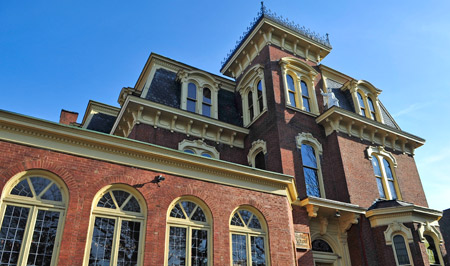
The Ursuline Academy (dates back to 1894), a Catholic girls school, opened in its Bloomfield location in 1894 and closed in 1981. In 1993, the building was sold, restored and named Victoria Hall, a venue for weddings and celebrations. The Waldorf School bought the property in 2003. Sidney Davis | Pittsburgh Tribune-Review
The ornate wood and plaster work inside the former Ursuline Academy in Bloomfield has been around for about 140 years.
A nomination to the National Register of Historic Places next month could ensure it lasts at least twice as long.
The building on South Winebiddle Street near the borders of Friendship Park, Garfield and Lawrenceville has been a hands-on laboratory for University of Pittsburgh students learning how to research historic buildings. The students will release their findings to the public at 7 p.m. Tuesday in the building’s auditorium.
The class plans to present the nomination to the Pennsylvania Historical and Museum Commission in January. If approved, the commission would send it to the National Park Service in Washington for a final review.
Officials with the building’s current tenant, the Waldorf School, a private school for students in kindergarten through fifth grade, applaud the efforts.
“It’s a wonderful place to have a school,” said Alexandra Gruskos, Waldorf’s board president and an attorney for the Allegheny County Office of Children, Youth and Families. “We’re very happy about the nomination.”
Students in Jeff Slack’s documentation and conservation studio course pored over historic maps, photographs, deeds and building permits in researching the history of the 21-room mansion built for Henry J. Lynch in the late 1860s.
“The nomination is the result of the ongoing work begun in 2008 by Pitt preservation students that included a detailed evaluation of the physical condition of the building,” Slack, a historic preservation planner at Pfaffmann + Associates, PC, Downtown, said in a written statement.
“But this year, the students’ work focuses more so on research that shows the far-reaching educational contributions of the Ursuline Academy to the local community.”
The historic designation would prevent federal money from being used to alter the building, said Brendan Froeschl, facilities manager for the Waldorf School. The building was well-preserved because it was turned into a school after initially being a residence, he said.
“The Ursulines did a wonderful job. When you come in the front door, you’re in the front door of the original mansion,” Froeschl said.
Dan Holland, director of the Young Preservationists Association of Pittsburgh, said other buildings across the city would benefit from the expertise of the class.
“To do this kind of work is a huge help,” Holland said.
The Ursuline Academy, a Catholic girls school, opened in its Bloomfield location in 1894 and closed in 1981. In 1993, the building was sold, restored and named Victoria Hall, a venue for weddings and celebrations. The Waldorf School bought the property in 2003.
-
Hotel Saxonburg Chef Returns to Recently Renovated Landmark
By Pam Starr, FOR THE PITTSBURGH TRIBUNE-REVIEW
Sunday, December 12, 2010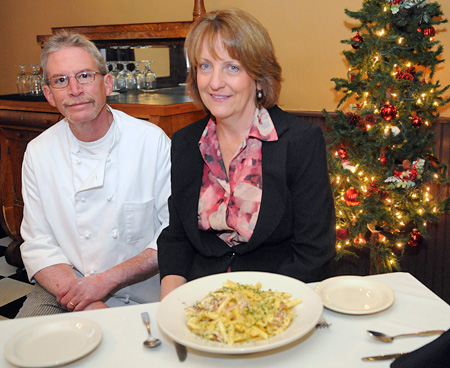
Hotel Saxonburg's executive chef, Alan Green, and owner, Judy Ferree, with Penne Carbonara Erica Hilliard | Valley News Dispatch
Judy Ferree loved Hotel Saxonburg so much as a customer that she decided to buy the Butler County landmark in July.
The former owner, Domenic Gentile, had died a few years ago, and his wife realized she couldn’t keep the restaurant going, says Ferree, a resident of Middlesex.
“I thought this would be a good project,” says Ferree, 50, who used to own Lakevue Athletic Club with her husband, Bob, and managed Butler Country Club for a number of years. “I had watched it slide, partly due to the economy, but I wanted to get Hotel Saxonburg back to where it was.”
Ferree closed the place for five weeks for needed renovation. All of the kitchen equipment was replaced, including the refrigeration units and ventilation system, and the entire interior was painted. The original tin ceiling in the dining room was repaired and painted.
But Ferree was careful to keep the old-fashioned charm and elegance that Hotel Saxonburg is known for. Hotel Saxonburg was built in 1832 and is listed in the National Registry of Historic Places. The black-and-white checkered floor tile is still intact, and the copper-topped bar dates to the 19th century. Five upstairs sleeping rooms have been meticulously refurbished to reflect the 1800s. Ferree points out that Woodrow Wilson once stayed there.
The 138-seat Hotel Saxonburg is the oldest continually operating restaurant and bar in Butler County, she says.
“We reopened on Aug. 12, and it’s been exciting,” she says. “It’s livened up the whole community. I brought back the chef, Alan Green, who was here for 18 years and left to work at the Springfield Grill for four years. He’s the heart of the place and is so approachable and humble. He’ll be the first one to jump in and help the dishwasher.”
Green, 55, has been cooking professionally for 35 years and hand-picked the culinary team when he returned. The Aliquippa native began his career while a student at Penn State, where he graduated with a Spanish degree.
“I cooked my way through school, and my knowledge of Spanish was invaluable while working as a chef in Washington, D.C.,” he says. “When I hire someone, the first thing I look for is enthusiasm, and the ability to look me in the eye. They also need to be able to take criticism.”
Green is very pleased with the chefs and cooks who work with him at Hotel Saxonburg.
“I have some young guns here that are terrifically talented but need steady guidance,” says Green, who is married and lives in Butler. “I can’t marathon anymore at my age, so I teach. I also try to learn something every day.”
The American menu is Green’s creation. He wanted to return to the classics, he says, as well as keep up with trends. His appetizers include staples such as crab cakes, fried asparagus and shrimp cocktail. But one will also find zucchini cakes with roasted red pepper sauce; ground beef sliders; Crimini mushrooms filled with clam stuffing and topped with bacon; and grilled New Zealand lamb chops.
Hotel Saxonburg is famous for its lobster bisque, and Green wouldn’t dream of taking that off the menu. Entrees feature classics such as filet mignon, baby back ribs, chicken gorgonzola and seafood pasta. Green includes other items like sauteed black sea bass filets; satay fire-grilled chicken skewers with wild mushrooms and marinara sauce; shrimp tempura with sweet Thai chile sauce; and cucumber-crusted salmon filet with a cucumber-wasabi puree.
Everything on the menu is made from scratch, he says.
“We get our seafood from Curtze Foods in Erie, and some from Pittsburgh Seafood,” Green says. “Our chicken, lamb and beef comes from Curtze, and US Foods. Our specialty products are from Thoma’s, right down the road, and their pork is superior. Perriello Produce in Natrona Heights handles our produce. They’re all good guys.”
The hours are the hardest part of being a chef, he says, but the “happy stuff far outweighs the dark stuff.” Writing cookbooks is on Green’s bucket list, and the first one will be about soups.
“All I do is think about food,” he says with a laugh. “I read food, I study food, I watch food. Cooking is very rewarding. When you get one customer who tells you how nice their dinner was, it makes your month.”
Penne Carbonara
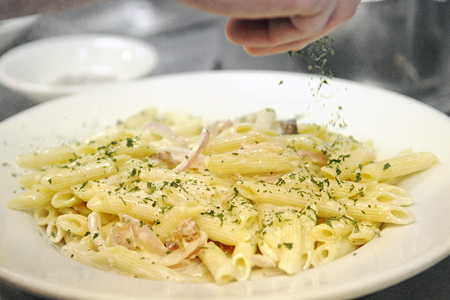
Chef Alan Green is sharing is popular Penne Carbonara recipe. He uses local bacon from Thoma's to give the dish more oomph, and uses an egg in the final phase to thicken the dish. Erica Hilliard | Valley News Dispatch
Chef Alan Green is sharing is popular penne carbonara recipe. He uses local bacon from Thoma’s to give the dish more oomph, and uses an egg in the final phase to thicken the dish.
“The egg is a delicious way to enhance and enrich the flavor,” says Green. “The sauce should be just thick enough to coat the noodles. This is a good, wintery pasta dish that fills you up.”
He suggests serving this hearty meal with whatever wine you enjoy.
- 3 tablespoons clarified butter
- 2 tablespoons red onion, julienned
- 1 teaspoon minced garlic
- 1/4 cup thick-sliced bacon, diced
- Salt and freshly ground black pepper, to taste
- 1/2 cup heavy cream
- 12 ounces cooked penne pasta
- 1/4 cup grated Romano cheese
- 1 large egg
- 2 tablespoons chopped parsley
Put the butter, red onion, garlic and bacon in a saute pan over medium-high heat. Sweat the onion and garlic for about 2 minutes, and season with salt and pepper.
Add the heavy cream and bring to a boil. Reduce the heat and simmer until reduced by half.
Cook the pasta according to package directions, and drain well. Add the cooked pasta to the cream mixture and season again with salt and pepper. Add the Romano cheese, and then remove from the heat. Stir in the egg and mix well.
Place the pasta in a serving bowl, sprinkle with chopped parsley, and serve immediately.
Makes 2 servings.
Hotel Saxonburg:Cuisine: American
Hours: 11 a.m.-10 p.m. Tuesdays-Thursdays, 11 a.m.-11 p.m. Fridays and Saturdays, 11 a.m.-9 p.m. Sundays
Entree price range: $10-$23
Notes: Major credit cards accepted. Handicapped accessible. Reservations recommended for weekends. Bottles of wine for $15 featured on Tuesdays and Thursdays. Sunday brunch. Five hotel rooms upstairs.
Address: 220 Main St., Saxonburg, Butler County
Details: 724-352-4200 or website
-
Public Gets Hands-On With Ideas for South Park Fairgrounds
Thursday, December 09, 2010By Margaret SmyklaThe public put its money where its mouth was during a public meeting last week about the future of the South Park Fairgrounds.
Everyone in the audience was given $500 in fake money to play a kind of board game, placing the “money” on an element that the player thought was a priority.
Elements receiving heavy play included removing Schoonmaker Hall, improving the oval fields/track surfaces and enhancing the park gateways.
A popular write-in item was “improving bathrooms.”
The input from this meeting, as well as another public meeting in September and focus groups and an online survey will be incorporated into a report from GAI Consultants, of Homestead, that is planned for completion at month’s end.
The study is supported by the Richard King Mellon Foundation, the Heinz Endowments and the county.
While there is no money in hand for improvements, the county is more likely to receive funding from foundations, and the state and federal governments, if a plan is in place, said county parks director Andy Baechle. There is no timetable.
The process was set in motion through a master plan created several years ago for all nine county parks. One of its recommendations was the formation of a nonprofit parks foundation to which tax-deductible donations could be made.
That done, the master plan was again addressed, such as its call for a detailed vision of the 76 county-owned acres from Corrigan Drive to McCorkle Road encompassing the Fairgrounds, exhibit hall buildings, amphitheater, police barracks, Nature Center, tennis/basketball courts, and more.
“This area has a tons of potential, but it has lagged,” said Jeaneen Zappa, the Allegheny County’s sustainability manager.
At the meeting, three options — titled “Modified,” “Campus” and “Picturesque” — were presented to solicit comments from the audience.
The “Modified” option is based on what can be done fairly easily and economically, such as removing/repairing bleachers, improving oval fields/track surfaces and enhancing park gateways.
With “Campus,” which emphasizes pedestrians, the recommendations include removing Agricultural Hall for additional parking, adding a “green” parking lot at McCorkle and Brownsville roads and reclaiming the southern end of Catfish Run.
“Picturesque” focuses on the naturalistic quality of the park’s original planning, such as reconfiguring the oval track to curvilinear shape, relocating the tennis/basketball courts and relocating the nature center adjacent to Catfish Run.
Ms. Zappa said the final report will likely include elements of all three,
Christine Fuller, executive director of the Allegheny County Parks Foundation, said the organization will review the final report and work with the county on the next steps.
After the meeting, Jeff Danchik, director of the Mon Valley Express, a drum and bugle corps which leases space from the county at Brownsville Road and Corrigan Drive, said the area needs more attractions, such as a craft shows or flea markets.
“A lot of people don’t know we’re here,” Mr. Danchik said.
Walt Sackinsky of South Park said he would like to see the infrastructure addressed, such as aging water, gas, and sewer lines, and fire hydrants.
For Terry Tressler of South Park, priorities include improvements to Corrigan Drive such as adding a middle turning lane with room on each side of the road for walkers and bikers.
His wife, Donna Tressler, would like to see Schoonmaker Hall, which is used for storage, razed. “It is falling down and dangerous, with kids going in and out,” she said.
A big priority for both is improving the bathrooms.
The couple, lifetime park users, are hopeful for change after attending both public meetings.
“I’m impressed with the caliber of people who seem to want to improve the park,” he said.
-
Buying Here: Bellevue
Saturday, December 04, 2010By Rosa Colucci, Pittsburgh Post-Gazette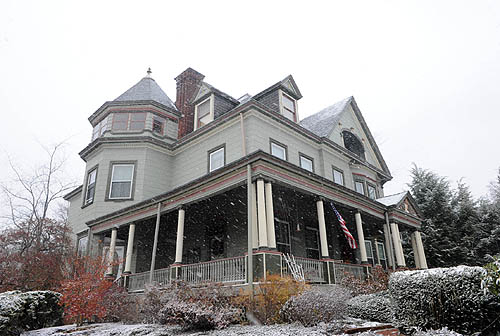
This five-bedroom, 4 1/2-bath home in Bellevue has 5,500 square feet of living space. Michael Henninger/Post-Gazette
“It takes my breath away every time I walk through the front door. It’s a warm, wonderful house,” says Sharon Hruska of her house in Bellevue.
There are very few houses that can evoke that feeling, but she isn’t exaggerating. Her five-bedroom, 4 1/2-bath Queen Ann-style house at 108 Meade Ave. (MLS No. 841177) is on the market for $299,000 through RE/MAX Realtors Don and Kathy Seaton (724-933-6300, ext. 664; or www.seatonteam.com).
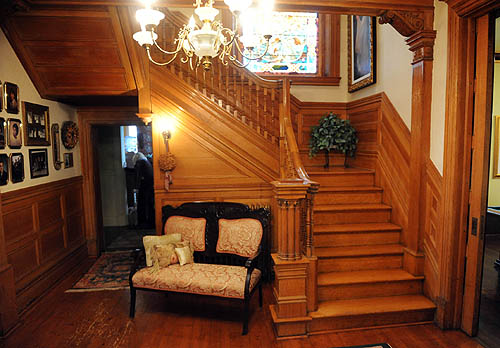
The home was built in 1898 by a lumber mill owner, who spared no expense on the wood work, including the entryway that has a carved oak staircase. Michael Henninger/Post-Gazette
When you open the front door, you are greeted by a 30-by-8-foot entryway that features a carved staircase in gleaming oak. The home was built in 1898-99 by Michael Simon, who owned a lumber mill and spared no expense.
When Sharon and Ken Hruska purchased it in 1993 for $40,000, its more than 5,500 square feet of living space was divided into nine apartments. The splendid foyer and all other woodwork were painted white. The couple spent a year restoring the home before moving in.
“My husband stripped the foyer. It took him one solid year; he worked every single day,” Mrs. Hruska said.
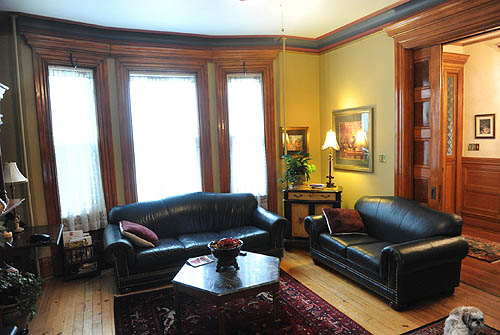
There is plenty of room to entertain in the 19-by-16-foot family room. Michael Henninger/Post-Gazette
This and other labors of love are evident in every nook and cranny of this grand home. The main living level has six fireplaces and an assortment of rooms perfect for entertaining. The living room (parlor) measures 18 by 16 feet and has 9-foot ceilings, tall windows and a picture rail. The 19-by-16-foot family room has a carved fireplace and a more masculine feel, decorated in traditional leather. The dining room (26 by 15 feet) has a pair of chandeliers and another fireplace, this one with a ceramic tile hearth offsetting the hardwood floors that cover most of the first floor.
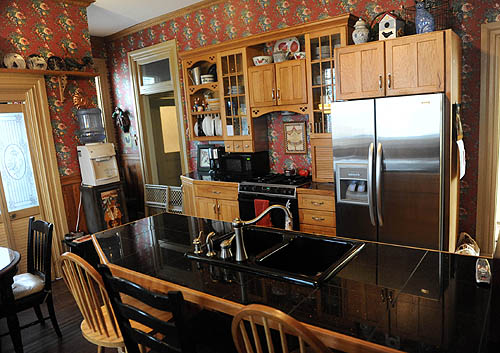
The 27-by-15-foot kitchen has granite counters and stainless-steel appliances. Glass-front cabinet doors flank the cooking area and accent exposed shelving. Michael Henninger/Post-Gazette
The 27-by-15-foot kitchen is a cook’s dream, with granite counters, stainless-steel appliances and an exposed-brick wall that nicely complements the modern appliances and amenities. Glass-front cabinet doors flank the cooking area and accent exposed shelving.
Nearby is the 18-by-16-foot den that doubles as a billiards room. Rounding out the main level is laundry room that measures 16 by 16 and a powder room.
A back staircase offers access to the huge third floor that could be rented as a full apartment. The space has three bedrooms, a full kitchen, living room and full bathroom.
Going up the front staircase to the second floor, be sure to stop to admire the majestic stained-glass window that the homeowners were able to retrieve and put back in place years after they bought the house.
The master bedroom has a trio of windows, a full master bath suite with a jetted tub that faces a fireplace, a stand-alone shower and a pedestal sink. There are two more full bathrooms and two more bedrooms (one of which is being used as an office). Room sizes range from 14 by 14 feet to 17 by 16 feet.

The master bath has a jetted tub that faces a fireplace, a stand-alone shower and a pedestal sink. Michael Henninger/Post-Gazette
The home is heated by radiator heat and cooled by room air conditioners, which stay with the home. Outside, the stunning wrap-around porch could entertain 50 people. The homeowners added a separate three-car garage to accommodate family and friends.
Now planning to downsize, the Hruskas say their grandchildren don’t want them to leave this house and friendly neighborhood, where many young families have moved recently. The house is open by appointment.
The property has a full market value of $155,000 (www2.county.allegheny.pa.us/RealEstate). In the past three years, four properties have sold on Meade Avenue ranging in price from $48,900 in April 2010 to $113,000 in June 2008 (www.realstats.net).
“Sometimes you go in big old houses [and] they have a creepy, scary feeling,” Mrs. Hruska said. “We have always felt at home here since the day we walked through the front door.”
 Bellevue
Bellevue
At a glance- Website: bellevueboro.com
- Size: 1.1 square miles
- Population: 8,770 (2000 census)
- School district: Northgate (northgate.k12.pa.us)
- Enrollment: 1,294
- Average 2010 SAT scores: 476 verbal; 494 math; 470 writing
- Current taxes on 108 Meade Ave. (full market value of Strong55,000): $6,019
- Municipality: $1,085 (7 mills)
- School district: $4,278 (27.6 mills)
- County: $656*
- Wage tax: 1 percent, split between municipality and school district
- A little bit of history: Like many northern suburbs, Bellevue originally was part of the Depreciation Lands reserved for Revolutionary War veterans. It has the distinction of being incorporated in 1876 only after Frankie East was born. Frankie’s birth gave the town a population of 300, the necessary prerequisite for residents to file a petition for incorporation with the Allegheny County Court of Quarter Sessions.
*Includes the Act 50 Homestead Exclusion, which reduces assessed market value by $15,000 for county taxes.



